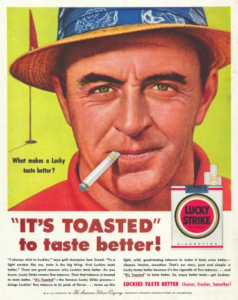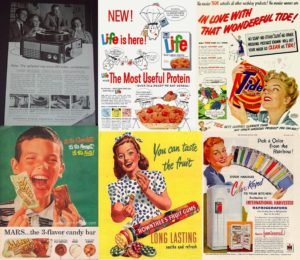From Product to Customer Centricity to... The Next Era in Retail
You’ve heard it before, the only constant in life is change. And as cliche as it may be, I am hard pressed to find a situation in which this doesn’t shine true.

Author: Janelle de Weerd
Have a look at yourself today, think about hobbies, relationships, job, interests. How many of these areas remain the same today as they did five years ago, and what about in ten years, twenty?
Now consider how you have changed as a consumer. How many of these changes were instigated by your own internal drives as opposed to external? This is likely a difficult question to answer.
Much of how we as consumers shop has been shaped by how brands advertise their products. A lot has happened behind the scenes of marketing.
We have seen a mindshift from marketing product features and USPs to marketing the value in which products create.
Let’s step into the DeLorean Time Machine to gain a clear picture of how we’ve arrived at the current market climate.

The Dawn of Marketing: Product Centricity
This story begins in the office buildings thick with the endless stream of cigarette smoking drifting from executive offices and cubicles alike.
Oh yes, I’m talking about the age of the Mad Men – brilliantly brought to life with the legendary character Don Draper in the AMC series, well, Mad Men.
At that time, the product stood at the center of everything these advertising bandits put out. In fact, Rosser Reeves, who ran a large advertising agency, touted the benefits of product USPs (unique selling points). He believed that a product’s USP should stand at the center of the advertisement and continuously repeated so it embedded itself into the “rational” mind of the consumer.
“It’s Toasted” represents the element of Lucky Strike cigarettes that the ad and company execs wanted to promote to differentiate their cigarette in the market. This came at a time where all the major brands were coming to terms that they could no longer use health claims from doctors.

Actual Advertisement from 1954
But it’s not only cigarettes that used this USP focus. Virtually all of the ads from this time followed the same format.

Product-centric ads from the 1950s
These advertisements put the product at the center of the message. And by doing so, disregarded the customer who was buying it.
Who cares if a Mars bar is “3-flavor”? Or that the Kodak Carousel’s “spillproof tray shows 80 slides… automatically”.
Perhaps someone does. However, these ad-lines were made purely on gut instinct and creativity alone. And after a while of trying to make this approach work, the subtle force of disruption started to make waves in the industry.
The Influence of Consumer Psychology on Advertising
One of the first to shake up the advertising industry was Dr. Herta Herzog, who introduced a new way of marketing to the public. Herzog, who is referred to as the Godmother of Customer Voice, introduced methodologies such as “focused interviewing” and qualitative research to the advertising industry.
For the first time, customer interviews focused not on what individuals did but why they did it.
She looked at the emotional needs of the target group and how products would fit into their lives, the gratification they would receive from it.
“[Herzog] wouldn’t ask about hair-color products in order to find out about you, the way a psychoanalyst might; she would ask about you in order to learn about hair-color products.
[She proved] that the products and the commercial messages with which we surround ourselves are as much a part of the psychological furniture of our lives as the relationships and emotions and experiences that are normally the subject of psychoanalytic inquiry.” Malcolm Gladwell
This milestone in the advertising industry gave way to marketing products in a way that showed how products fit into the consumers’ lives. And since then, we’ve come a long way in customer-centricity.
The Age of Customer-Centricity
With the stage set and the evidence put forward, customer centricity as a strategy took off. Brands quickly realized that placing their products in the greater pictures of the customers’ lives was far more effective than picking and choosing which product USP would sell best.

Several examples from the brands above with more recent examples. These customer-centric ads were surprisingly difficult to track down, likely due to the industry’s pivot from print ads.
Needless to say, we’ve come a long way from the suits, skirts, and cigarettes of the Mad Men age. Not only have work conditions developed greatly – hello clear lungs! – the methods in which to interact with your customers has increased tenfold.
Today, no matter the industry in which you work, customer centricity is deeply embedded in how you do business. That means understanding your customers to such a degree that you speak the same language and prove your relevance in their lives.
It also means being where they are, which means, in the case of retail, dispersed across countless digital and physical channels.
Enter: Omnichannel
As cliche and jargon-esque it may be, omnichannel and communicating to your customer through all channels has become the modern day challenge. So how do you ensure you’re putting your customer at the center of your decisions, while maintaining a consistent, relevant experience?
Well, long story short: data, data, data!
Technology now enables us to study the real behavior of our customers through technology like AI, IoT, advanced analytics, and so on. Granted, the sheer amount of data at your disposal is baffling. But given the right tools to make sense of data, key to learning about your customer’s behavior.
Companies like Amazon have used data processing technology to streamline their customer experiences, making the online journey so seamless that a shopper can go from browsing to shipping under five minutes.
They have optimized their supply-chains to offer things like 2-day shipping and free returns. Amazon has played a critical role in setting consumer demands at an all-time high by being relentless about serving the customer.
These shifts in the market have changed the way we as consumers shop and brands sell. Leaving retailers born from wholesale or brick and mortar scrambling to catch up.
As a result, technology providers offer a wide range of products to help retailers achieve true customer centricity. Ranging from campaign segmentation tools to personalization engines, these tools reuse data to facilitate better customer experiences.
This approach has changed the nature of shopping both online and offline. Segmenting audiences based on location, source, or even product viewed has helped marketers to improve the relevancy of the messages they are sending to their audiences.
Being customer centric has helped retailers to create a clearer picture of how their products fit into the lives of their customer segments.
Bridging the gap between customer and product centricity
The transition to customer centricity was a necessary one. It nudged retailers to think about who they are serving, and by doing so, made marketing and merchandising a two way street.
However, due to the technology at our disposal, we are witnessing another shift in the retail industry. This shift is being brought about by a complex retail environment that is congested and has an increasingly lower barrier to entry.
Today’s retailers need to find ways to become more relevant to their customers to ensure they stand out and give the superior customer experience.
To do so, they need to bring together the worlds of customer and product centricity by leveraging creative approaches to collecting product data and using this for cross-company decision making.
For example, what product attributes are most attractive to different segments? And how can these be used to inform segmented marketing decisions, (digital) merchandising, or in-store product promotion?
The next era in retail will be one that customer experience isn’t only personalized but the products themselves are personalized. This will drive product-driven customer experiences that will make product collections more relevant and product communication more effective.
It’s time to channel our inner Mad Men using the knowledge we have today. Except, this time around, instead of relying on assumptions and instinct, we have the data to support our claims.
Itching to learn more? Join me on March 20th at inOrbit to learn how retailers are already leveraging this approach with innovative solutions.


